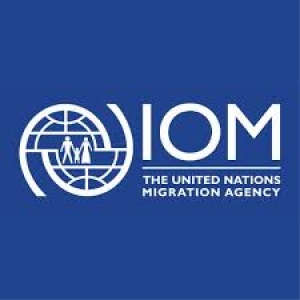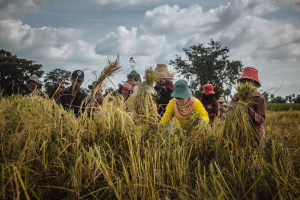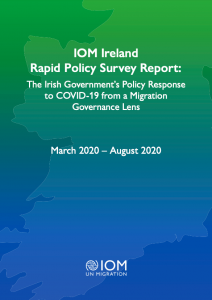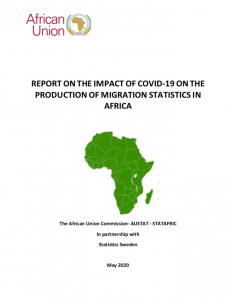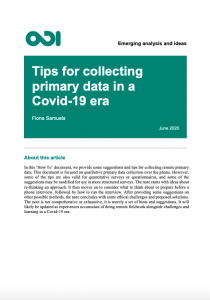COVID-19’s impact on migration data
Policy aimed at addressing the impacts of the pandemic must include migrants, both to protect migrants working on the frontline of the response and those most vulnerable. Such policy hinges on the continued collection and analysis of robust data on migrants and migration-related issues. The outbreak of COVID-19 and the ensuing mobility restrictions and reprioritization of resources has in many cases exacerbated the existing challenges to migration data. Both the collection of statistics on regular and irregular migration have been affected.
Delays and changes to official censuses and surveys
COVID-related challenges to censuses and surveys profoundly impact the collection of migration data, as well as population statistics more broadly. With 150 countries scheduled to conduct census enumeration between 2020 and 2021, the pandemic is likely to disrupt data collection through delays, interruptions or cancellations, all of which can compromise the quality of census data. Similarly, as many surveys are conducted via face-to-face interviews, COVID-related mobility restrictions have hindered the collection of vital survey-based migration data.
These data, which are typically collected by national statistical offices (NSOs), play a vital role in the body of evidence on migration. A survey conducted by the African Union Institute for Statistics (STATAFRIC) with 47 NSO respondents from across the continent confirmed the negative effect COVID-19 has had on data collection on migration. 87% of the respondents reported that surveys with migration modules will be negatively impacted by the pandemic, with another 72% stating that administrative sources will be affected. Another 68% of NSO respondents across Africa stated that COVID-19 is likely to hinder the implementation of population and housing censuses.
Another survey conducted by IOM’s Global Migration Data Analysis Centre with 15 NSOs shortly after the outbreak of the pandemic showed that there were both increased demands for migration data and decreased capacities to collect and analyse such data because of the pandemic. The respondents, who were staff at NSOs in countries across Europe, Africa, Asia and the Americas, reported widespread demands for increased disaggregation of data by migratory status, especially in healthcare and employment sectors, as well as on irregular migration and seasonal workers. However, most NSO respondents had been negatively impacted by the outbreak of the pandemic, with most reporting delays to censuses and surveys, and cuts to statistical offices budget and staff hours.
Challenges to measuring irregular migration movements
Beyond official data sources, data on irregular migration movements, which often requires the in-person presence of key transit hubs, has also been profoundly limited by the COVID-19 pandemic. For example, the Mixed Migration Centre (MMC) had to suspend its in-person data collection in all countries in early 2020 but adapted its Mixed Migration Monitoring Mechanism Initiative (4Mi) to a shorter COVID-oriented survey which could be conducted via phone rather than in face-to-face interviews. The new 4mi questionnaire includes questions on the impact of COVID-19 on refugees and migrants, their lives, migration journeys, risk awareness, access and barriers to healthcare and protection needs.
Though many routes likely saw fewer irregular movements due to extensive travel restrictions implemented to limit the spread of the virus, this was not always the case. Decreases in data on migrant flows and deaths linked to irregular movements are not necessarily an indication of a real drop since the pandemic. For example, IOM’s Missing Migrants Project received far more reports of ‘invisible shipwrecks’ – unverifiable cases in which ships carrying migrants disappear without a trace – in 2020 compared to prior years.
Why better migration data and evidence-based policies are more urgent now than ever
Understanding the contributions and vulnerabilities of migrants has become even more critical with the outbreak of the pandemic in 2020. Migrants make up a large proportion of the workforce in sectors important for the pandemic response in many countries hardest-hit by COVID-19. For example, many migrants are employed as healthcare workers. Among the 20 countries with the highest number of COVID-19 cases as of February 2021, at least 7 countries – the United States, France, Spain, the United Kingdom, Italy, Germany, Chile and Belgium – depend heavily on foreign-born workers in healthcare. For example, data from 2015-2016 indicates that 33 per cent of doctors and 22 per cent of nurses in the United Kingdom were foreign-born.
The data available on COVID-19 cases among migrant groups shows that migrants are more vulnerable to the spread of the virus than other groups. In particular, lower-skilled migrants in crowded dormitories have been disproportionately affected by the pandemic. In Saudi Arabia, for example, data from the national Ministry of Health indicates that 75 per cent of all confirmed COVID cases through May 2020 were among migrants. In Singapore, more than 95 per cent of cases confirmed by the Ministry of Health as of June 2020 were of migrants, with more than 91 per cent of all cases linked to crowded dormitory housing as of February 2021.
Specific migrant groups such as refugees and internally displaced persons and migrants in irregular situations are among those most vulnerable to the virus. This is linked both to the often-overcrowded settings in which they live, but also due to the travel restrictions and border closures imposed to stop the spread of COVID-19. It is estimated that more than 3 million migrants, including seasonal workers and international students, have become stranded and unable to return to their countries of origin due to COVID travel restrictions.
Migrant inclusion through data innovation: a better and more inclusive pandemic response
Considering COVID-19’s impact on migration data, it is critical to look beyond traditional sources and explore new opportunities, such as data from mobile phones, social media, and satellites. Anonymized mobile phone data has already been used in Italy, Estonia, and Ghana to measure the effectiveness of Covid-19 response policies. Social media data provide valuable insights into the spread of xenophobic rhetoric directed against migrants. Facebook advertisements can engage with migrant communities as specific target groups to collect data on COVID-related behaviors and vulnerabilities.
The pandemic has meant that collecting, analyzing and using more and better data on migration-related issues has become more important than ever. With the outbreak of COVID-19, the crucial role of migrants in key sectors during the pandemic as well as the heightened risks for certain groups have become increasingly evident. Without better data to support evidence-based policies, though, the contributions and vulnerabilities of migrants can be neither fully leveraged nor addressed. With the vast majority of evidence pointing to severe impacts on migration-related data collection, resources must be dedicated to ensuring that migrants are not left behind in the pandemic response, including their inclusion in vaccination campaigns.









